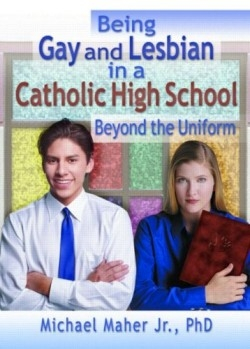Being Gay and Lesbian in a Catholic High School
Beyond the Uniform
The silence of high school curricula on the topic of homosexuality represents a symbolic “annihilation” of the gay and lesbian population and contributes to their sense of isolation. Such is one conclusion that writer Maher effectively reaches in this important study.
Set against a plan for Catholic high schools to create a total environment of familial, social, institutional, spiritual, and self-identity integration are the real-life experiences of gay and lesbian students during these years. In a quite compelling presentation of interviews with gay and lesbian graduates, Maher shows through anecdotal evidence that these students feel dis-integration, instead. Were this study based solely on such interviews, however, Maher’s conclusions would not have been as compelling. Rather, he includes data from two surveys, where Confirmation Candidates—both male and female—express agreement with statements on the surveys, and by so doing, reveals a truer measure of the factors that lead to feelings of dis-integration. Further, as a backdrop against both the interviews and the surveys, are a series of statements from the Catholic Magisterium on the subject of homosexuality and how both the Church and the families in the church should approach and minister to their homosexual members.
“I guess that I don’t feel loved anymore,” says one of the interviewees in the chapter on familial dis-integration, “at least not by my mom, because she doesn’t accept me for whom [sic] I am.”
In the chapter on institutional dis-integration another interviewee makes this plea: “They’re out there. You have homosexual students in your school. They’re probably hiding. You need to address some small part of the curriculum to them.”
In each of the five chapters dealing with one of the elements of integration that the Catholic Magisterium has said is necessary to “bring about the systematic transmission of culture to its students,” Maher presents first-person interviews that best illustrate the failure of that goal.
At the same time this study is well-reasoned and thought-provoking for counselors, teachers, and parents in the Catholic faith, it is also accessible to the gay and lesbian students the study encompasses. Just as importantly, non-sectarian teachers, counselors, and parents can glean valuable insights into the internal suffering of gay and lesbian students in the public schools.
Reviewed by
Ronald L. Donaghe
Disclosure: This article is not an endorsement, but a review. The publisher of this book provided free copies of the book to have their book reviewed by a professional reviewer. No fee was paid by the publisher for this review. Foreword Reviews only recommends books that we love. Foreword Magazine, Inc. is disclosing this in accordance with the Federal Trade Commission’s 16 CFR, Part 255.

